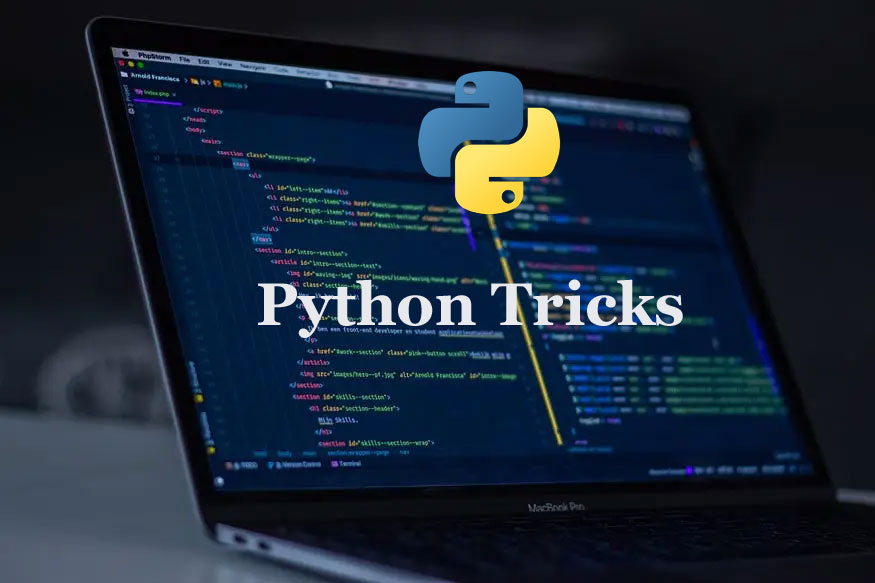You work with data all the time as a data analyst, cleaning, transforming, and gathering insights. Python is an effective tool for all of this, and you’ll work more efficiently and effectively if you have knowledge of its hidden advantages.

10 Python Tricks Every Data Analyst Should Know
Let’s go over ten essential Python tips that every data analyst should need to understand why to use, everything explained in a friendly way.
1. Use List Comprehensions for Useful Data Handling:
Looping through large datasets can be slow. Instead, use list comprehensions for a more elegant, quick solution.
For Example:
python
# Squaring numbers in a list
numbers = [1, 2, 3, 4, 5]
squared = [x**2 for x in numbers]
print(squared) # Output: [1, 4, 9, 16, 25]
Why? Compared to a standard loop, it is faster, cleaner, and simpler to read.
2. Make use of Lambda Functions to Transform Data Fast:
There are numerous circumstances when you need to use an essential function quickly without writing an entire function definition.
For Example:
python
# Doubling numbers using lambda
double = lambda x: x * 2
print(double(5)) # Output: 10
This trick works very well for successfully turning lists when employed in connection with map().
3. Implement the use of apply() Pandas uses loops instead of loops:
These can slow down dataframe operations. When it comes to effectively applying functions, apply() is innovative.
For Example:
python
import pandas as pd
data = pd.DataFrame({‘values’: [10, 20, 30, 40]})
data[‘double’] = data[‘values’].apply(lambda x: x * 2)
print(data)
speeds up estimation in comparison with row-by-row repetition.
4. Quickly Review Data in value_counts():
Value_counts() is your best friend if you need to count the unique values in a dataset.
For Example:
python
# Counting events in a column
data = pd.Series([‘apple’, ‘banana’, ‘apple’, ‘orange’, ‘banana’, ‘apple’])
print(data.value_counts()
Avoid the necessity to write difficult loops in order to calculate frequency distributions.
5. Apply groupby() to Work with Aggregates:
Splitting data into groups and analyzing patterns becomes effortless with groupby().
For Example:
python
import pandas as pd
data = pd.DataFrame({‘category’: [‘A’, ‘B’, ‘A’, ‘B’], ‘value’: [10, 20, 30, 40]})
print(data.groupby(‘category’).sum())
Suitable for quickly describing large datasets.
6. Apply str.contains() to enhance String Operations:
Looking for specific patterns in text data? Skip manual searching—use str.contains().
For Example:
python
# Filtering rows based on text content
data = pd.DataFrame({‘name’: [‘Alice’, ‘Bob’, ‘Charlie’], ‘status’: [‘active’, ‘inactive’, ‘active’]})
active_users = data[data[‘status’].str.contains(‘active’)]
print(active_users)
Enhance text processing speed without employing detailed loops.
7. Apply pd.to_datetime() to Convert Date Columns:
Manually managing dates can be painful. Apply pd.to_datetime() to convert them immediately.
For Example:
python
data = pd.DataFrame({‘date’: [‘2025-04-01’, ‘2025-05-03’, ‘2025-06-07’]})
data[‘date’] = pd.to_datetime(data[‘date’])
print(data)
helps ensure the fact that each date is formatted correctly for time-based analysis.
8. Get Descriptive Statistics with describe():
Get a summary all at once rather than manually calculating essential statistics.
For Example:
python
# Quick stats
import pandas as pd
data = pd.DataFrame({‘values’: [10, 20, 30, 40, 50]})
print(data.describe())
Provides a beneficial overview of numerical columns and saves time.
9. Pivot Tables for Flexible Data Summarized from:
When your data needs reorganization, pivot tables come in handy.
For Example:
python
data = pd.DataFrame({‘date’: [‘2025-04-01’, ‘2025-04-02’, ‘2025-04-03’],
‘category’: [‘A’, ‘B’, ‘A’],
‘sales’: [100, 200, 150]})
pivot = data.pivot_table(values=’sales’, index=’date’, columns=’category’, fill_value=0)
print(pivot) DataFrame({‘date’: [‘2025-04-01’, ‘2025-04-02’, ‘2025-04-03’],
Allows quick data reshaping for better analysis.
10. Use Seaborn for Stunning Visualizations:
Seaborn makes visualization of data easy and visually appealing, which is essential.
For Example:
python
import seaborn as sns
import matplotlib.pyplot as plt
import pandas as pd
data = pd.DataFrame({‘category’: [‘A’, ‘B’, ‘C’], ‘values’: [10, 20, 30]})
sns.barplot(x=’category’, y=’values’, data=data)
plt.show()
effortlessly generates graphs that are professional and easy to grasp.
Conclusion:
For data analysts who want to develop their Python capabilities and use them effectively in real-world situations, Console Flare is a valuable resource. Analysts can learn essential Python methods that speed up data processing, improve efficiency, and enhance analytical accuracy with Console Flare’s organized learning paths, real-world examples, and industry knowledge.
To make sure that data analysts can handle large datasets with minimal mathematics from above, Console Flare, for example, provides guidance on how to improve Python code for faster data processing. Advanced techniques such as using Seaborn to generate powerful visualizations, utilizing Pandas for effective data manipulation, and setting automation techniques into place to decrease manual labor are all covered in their tutorials.
Console Flare additionally shows how important it is to fully understand business challenges and transform technical learnings into valuable knowledge. This complete approach ensures that data analysts not only get technical knowledge but also promote the ability to successfully communicate results to stakeholders.
Data analysts can stay ahead of the other professionals in the analytics industry, make positive data-driven decisions, and greatly boost productivity by integrating these Python tips into their data analysis processes Console Flare allows analysts the tools they need to succeed, whether that means using pivot tables, improving string operations, or knowing list understandings.
Console Flare basically acts as a bridge between theoretical knowledge and real-world execution, which allows data analysts to take full advantage of Python’s potential for efficient and essential data analysis.
For more such content and regular updates, follow us on Facebook, Instagram, LinkedIn





